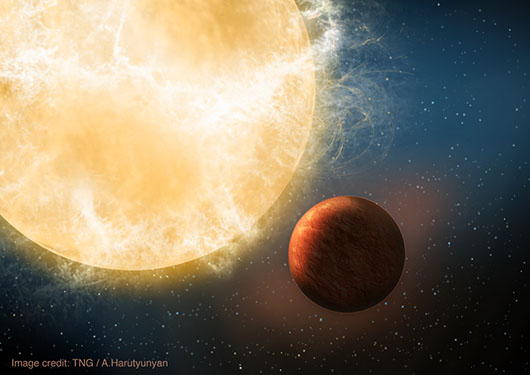New Earth-sized exoplanet that ‘shouldn’t exist’ baffles astronomers

Astronomers, including researchers at the University of St Andrews, have for the first time weighed an Earth-sized planet orbiting another star.
Although measuring the radius of exoplanets is relatively straightforward, measuring the planet’s mass – and therefore its density, a clue to its composition – is more difficult. The results from two independent teams published in Nature today (30 October 2013), one of which included a number of UK astronomers, confirm Kepler-78b as the first known Earth-sized exoplanet with an Earth-like density.
The results are baffling astronomers because Kepler-78b is a planet that shouldn’t exist. This scorching world circles its star every eight-and- a-half hours at a distance of less than one million miles – one of the tightest known orbits. According to current theories of planet formation, it couldn’t have formed so close to its star, nor could it have moved there.
Kepler-78b is about 20 per cent larger than the Earth, with a diameter of 9,200 miles, and weighs almost twice as much. As a result it has a density similar to Earth’s, which suggests an Earth-like composition of iron and rock.
“Achieving this measurement involved measuring the wobble of a star like the Sun that revolves around its common centre of gravity with the planet at a speed equal to human walking pace. This attests to the exquisite precision of the HARPS-North and HIRES instruments on which the European and US teams carried out their independent, cooperative studies,” explained Professor Andrew Collier Cameron, of the University of St Andrews, who leads the UK contribution to the project. The HARPS-North (acronym for High Accuracy Radial velocity Planet Searcher for the Northern hemisphere) spectrograph is a high-precision radial-velocity instrument. HIRES is a High Resolution Echelle Spectrometer.
Professor Don Pollacco, of the University of Warwick, added: “The detection of Kepler-78b is a tremendous achievement for the HARPS-N spectrograph. Not only is it one of the few confirmed planets with an Earth-like radius and density, but the accuracy of the measurements are close to the best ever achieved from the ground.”
In terms of mass, radius and mean density, Kepler -78b is the planet most similar to the Earth of the exoplanets for which these quantities have been determined. However, Kepler-78b does differ from Earth, notably in its very short orbital period and correspondingly high temperature.
The planet which tightly orbits a Sun-like star called Kepler 78 is now the smallest exoplanet for which both the mass and radius are known accurately. The tight orbit of Kepler-78b poses a challenge to theorists. When this planetary system was forming, the young star was larger than it is now. As a result, the current orbit of Kepler-78b would have been inside the swollen star. A planet cannot form inside a star and it couldn’t have formed further away and moved to where it is today as it would have migrated all the way into the star.
Kepler-78b is a doomed world. Gravitational tides will continue to draw Kepler-78b even closer to its star. Eventually it will move so close that the star’s gravity will rip the world apart. Theorists predict that the planet will vanish within three billion years. Interestingly, our solar system could have held a planet like Kepler-78b. If it had, the planet would have been destroyed long ago leaving no signs for astronomers today.
Dr Ken Rice, University of Edinburgh, said: “Although this planet is clearly too hot to support life, it is still very exciting to now be discovering planets that are not only similar in mass to the Earth, but also similar in composition.”
Dr Chris Watson, Queen’s University Belfast, concluded: “This result showcases the tremendous progress in this field, both in terms of advancing technology and developing innovative techniques. Just 5 years ago this work would have been impossible, and as we probe deeper and deeper what we are finding is that science fact is weirder than science fiction – the planet Kepler-78b certainly fits this bill.”
The University of Geneva is the lead institution in the HARPS-North project, with the Universities of St Andrews, Edinburgh and Queen’s University Belfast, the Harvard-Smithsonian Center for Astrophysics, and the Italian host Telescopio Nazionale Galileo as partners.
The St Andrews and Edinburgh contributions were part-funded by the Scottish Funding Council through the Scottish Universities Physics Alliance. Together with funds from Queen’s University Belfast, these contributions funded construction of the telescope interface and instrument control systems at the Science and Technology Facilities Council’s UK Astronomy Technology Centre in Edinburgh. The UK Astronomy Technology Centre instrument team were responsible for delivering the HARPS-North instrument Front End Unit, Calibration Unit, Instrument control electronics and software, Detector control system and Sequencer software. In addition they helped to install and commission the instrument on the Telescopio Nazionale Galileo (TNG) in partnership with colleagues from the University of Geneva and the TNG. STFC provides support for the exploitation of the science through grant funding to the UK universities.
Note to Editors
For image please contact the press office.
Issued by the Press Office, University of St Andrews
Contact Fiona MacLeod on 01334 462108 / 0771 414 0559.
Ref: (planet 30/10/13)
View the University’s latest news at www.st-andrews.ac.uk/news
Category Research